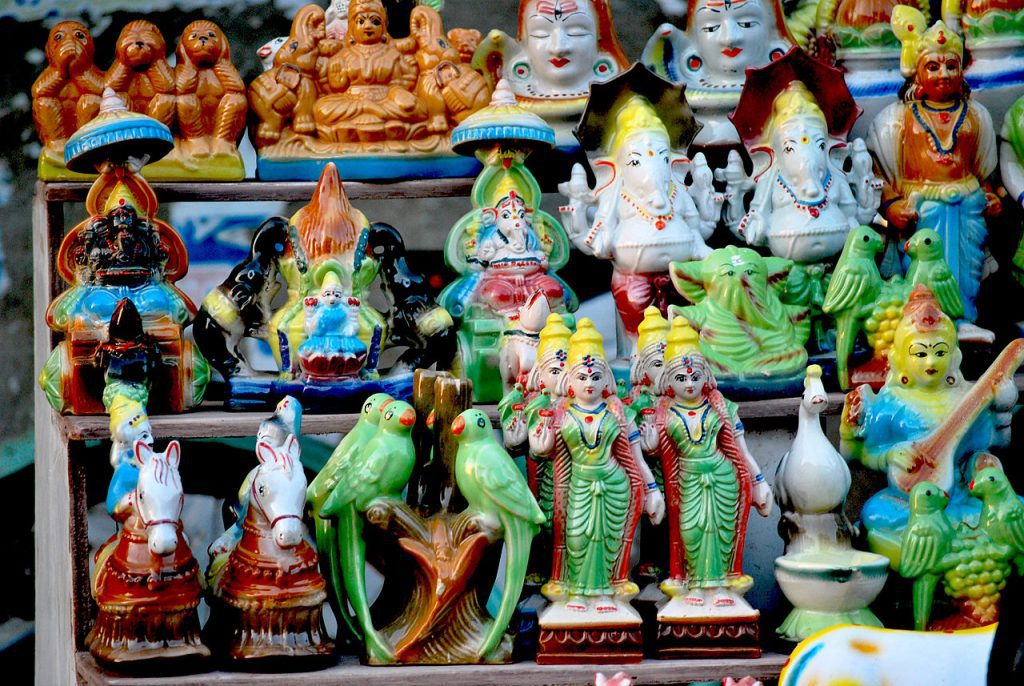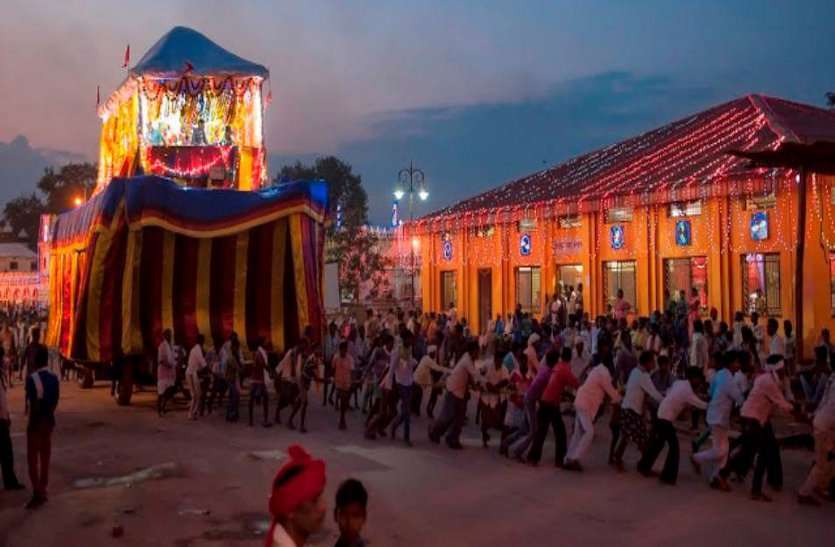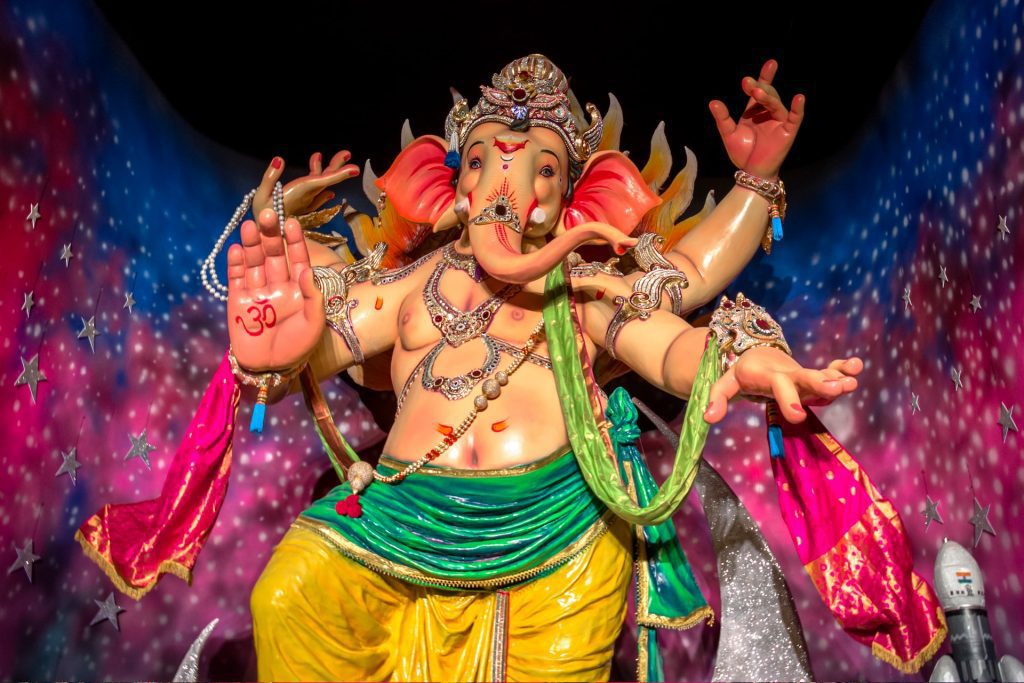Righteous, righteous, and brave! Maa Durga, the Divine Mother and the goddess of power who represents “shakti,” guards everyone against harm and pain. Be it the Bengali Durga Puja, Gujarati dandiya or the grand Mysore Dasara celebrations that commemorate the destruction of demon king Mahishasura — these festivals bring the country together in the triumph of good over evil. The common thread that ties them all together? The devotion, enthusiasm and sincerity of the people. Whether it is the months of preparation for Durga Puja pandals or the 75-day long tribal celebration in Bastar – every state has their own stories. Moreover, these festivities prove several ways devotees worship Goddess Durga.
Hindu mythology introduces Durga as the fearless, formidable warrior goddess who slays a vicious demon after he has been rendered invincible by any man or god. Her three fierce eyes, her ten hands holding ten weapons, and her ride on the lion depict her unassailable vigour. Today she stands tall as a glaring example of feminine energy on earth, so much so that Durga Puja has become a celebration of women and “Durga”, a synonym for women’s empowerment!
The Legend of Durga
The lore goes back to the half-buffalo demon, Mahishasur who did severe penance to please Lord Brahma. Seeing his devotion, Lord Brahma appeared and granted him a wish. Mahishasur wished that he be made the supreme power on earth, and in heaven – no man would be able to defeat him! Lord Brahma had to reluctantly grant his wish. Soon enough, Mahishasur became all-powerful and fearless, he wreaked destruction across earth and heaven. The devas of heaven collectively raised their concerns to Lords Brahma, Vishnu and Shiva. The three gods combined their powers to create a warrior ‘woman’ who would vanquish the demon, and Durga was created. She was the one-woman army who was bestowed with multiple weapons and powers from the devas, each sharing a copy of their own weapon. Vishu gave her his Sudarshan Chakra, Shiva gave her the Trishul, Ganesha gave her the sword and so forth.
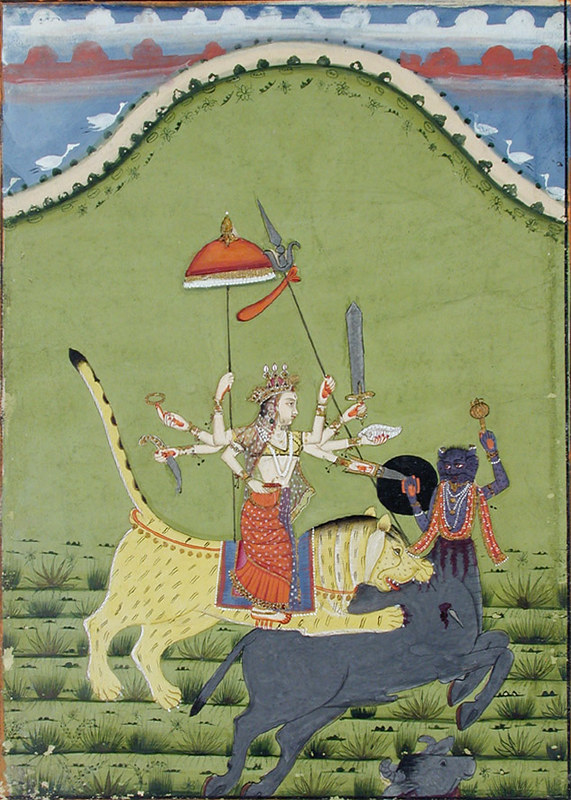
Durga on her lion, descended from the heavens and reached Mahishasur’s palace. In a harrowing 10-day battle, Durga fought fiercely and unleashed her divine wrath to destroy the demon’s various forms before beheading him on the 10th day. Durga is one of the best examples of a single entity embodying Ferocity as well as Compassion. Equal parts Destroyer and Creator, Durga’s life and story provide invaluable learnings for women of all ages, that within them resides the ability to be protector and care-giver.
Durga Puja in West Bengal
Although the festival takes different forms in different parts of the country, the central theme of worshipping the female form of power remains consistent. The theme is most prominent in West Bengal, where the celebration is dedicated to breaking the norms of patriarchy and social taboos around women. The modern day pandals are themed to glorify the various roles a woman takes up in her life – from a dedicated mother, wife and sister to a boss woman at work!
Durga Puja 2024 dates start from Wed, 9 Oct, to Sun, 13 Oct in West Bengal.
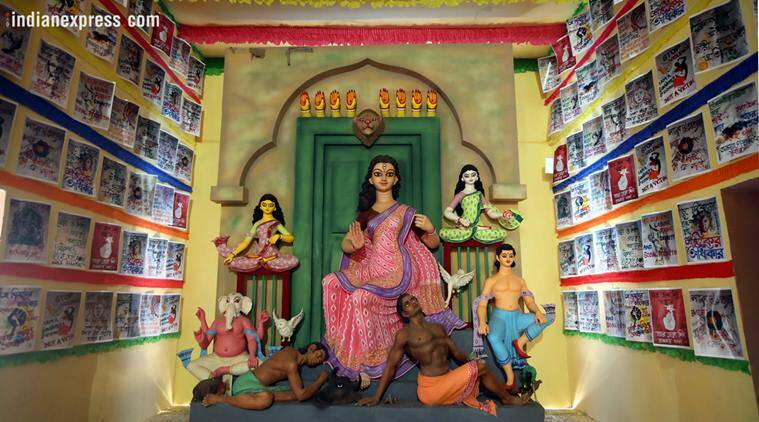
Credit: The Indian Express
Sindoor khela, which was previously a forte of married women, is open to all today – the sex workers, the transgender women as well as widows. In fact, the sex workers of Kolkata are endowed with the responsibility of organising pandals in Sonagachi, the city’s red light area. In the year 2018, the world’s first street graffiti art was unveiled which highlighted the struggles of these women and fought for their rights. One of the puja committees dedicated the year’s pandal to this theme, and special invitations were extended to these women to judge the puja competitions and participate in the various rituals.

The nine days of celebration in Kolkata is all about lauding the spirit and beauty of the feisty women of Bengal who are known for their gender neutral relationships!
Savaari Recommends: Some of the best pandals that you must visit during Durga Puja in Kolkata in 2024
- Santosh Mitra Square
- Bagbazar
- College Square
- Hindustan Park
- Hindustan Club
- Samaj Sebi Sangha
- Ballygunge Cultural Association Puja Pandal
- Deshapriya Park
- Kumartuli Park
- Ahiritola Sarbojanin Durgotsav
- Singhi Park Sarbojanin Durgotsab
- Mudiali Club
- Tridhara Sammilani Puja
- Shib Mandir Sarbajanin Durgatsab
- Bosepukur Sitala Mandir
- Naktala Udayan Sangha Puja
- Babubagan Club Sarbojanin Durga Puja
- Badamtala Ashar Sangha
- Suruchi Sangha
- Jodhpur Park Puja Pandal
We at Savaari are running Pujo discounts on local car rentals in Kolkata for pandal hopping. Book your ride today.
Kanya Puja in North India
Hindus across the country pay their tribute to Maa Durga by worshipping 9 prepubescent girls who represent the nine incarnations of the goddess. The ritual, known as Kanya Puja, is hosted on the eight and ninth days of Navratri.
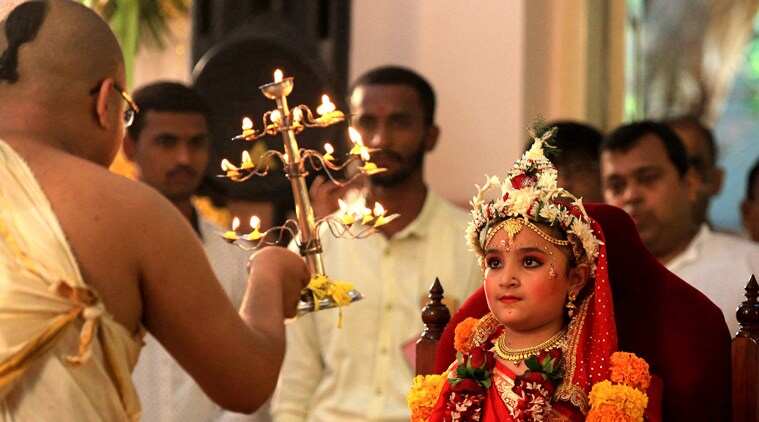
Credit: The India Express
The puja is traditionally performed by washing the feet of the girls, offering them new clothes, stationery items and cosmetics as gifts, and serving them the puja feast (a meal of halwa, chana and puri) before the other members of the house consume the same. It is believed that worshipping the little girls would give the devotees manifold returns for the prayers due to the feminine power vested in the girl child, who are considered to be the purest in Hindu mythology.
Kanya Puja is performed in several parts of North India, especially in Uttar Pradesh, Madhya Pradesh, Delhi, Haryana, Punjab and Uttarakhand.
Navratri: A Celebration of Women
Navratri is predominantly a celebration of women – the ‘Shakti worship’ or divine feminine power, where the female goddess is worshipped in all her manifestations. One can appreciate the deep symbolic significance of the festival in the current times, and how powerfully it resonates with the concept of modern-day women empowerment! Navaratri in 2024 will begin on Thu, 3 Oct, 2024 – Sat, 12 Oct, 2024.
To quote Feminism in India, “Maa Durga thus becomes a wonderful dichotomy that the society approves and ascribes to – she fiercely protects us from evil but she also looks after her family with love and care. Maa Durga successfully becomes a metaphor for modern women.”
Navratri in Gujarat
Navratri celebrations are essentially characterised by elegant and elaborate Garba festivities in Gujarat. Garba, a Sanskrit word for womb, symbolises life. And Garba, the folk dance of the state is performed to honor Goddess Shakti or Durga, the feminine form of divinity.
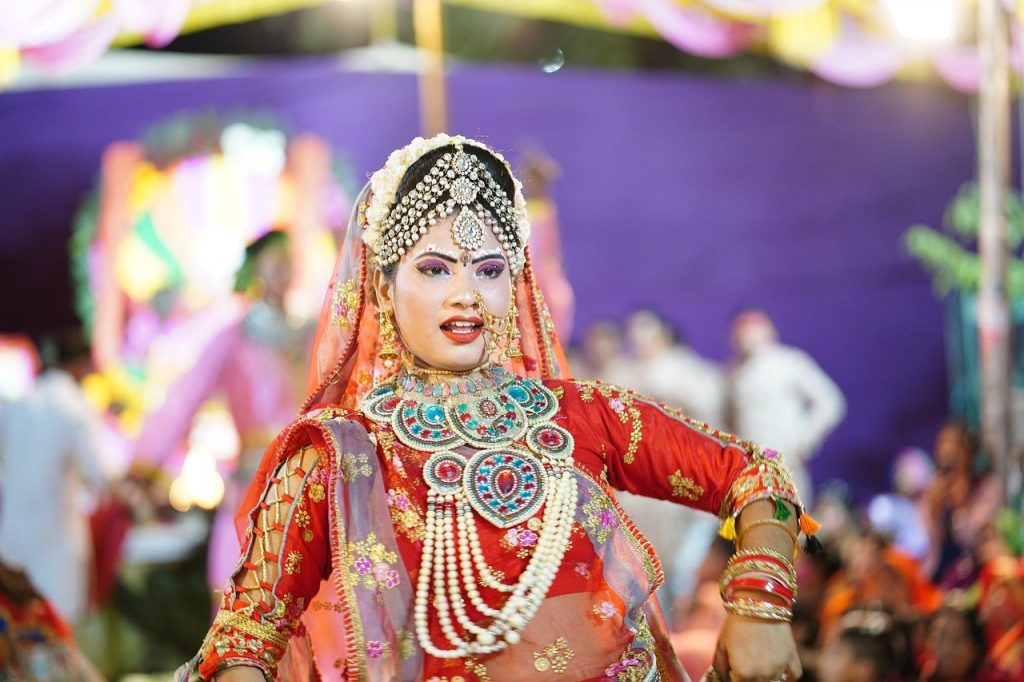
The significance of Garba for the womenfolk today lies in the fact that no matter the age or stature, they take a well deserved break and come out from their homes to revel in a night honoring the supreme woman power in an otherwise patriarchal society.
Savaari Recommends: Best Places to be in Gujarat during Navratri
- Vadodara
- United Way of Baroda
- The University of Baroda
- Shishu Sanskrutik Garba
- Ahmedabad
- Bhadra Fort
- Rajpath Club
- NID/CEPT
- Gandhinagar
- Gandhinagar Cultural Forum Ground
- Rajkot
- Race Course
- Khodaldham
- Surat
- Ena Navratri Mahotsav
Explore Navratri special offers on local and outstation rentals in all the cities and towns of Gujarat on Savaari cab booking app.
[Further read: Navratri celebrations in Vadodara]
Navratri in South India
Golu is a dolls festival celebrated during Navratri. It is included in Andhra Pradesh and Karnataka celebrations, in addition to Tamil Nadu. This festival is known as Bommai Golu in Tamil Nadu and Bommana Koluvu in Telugu. It is celebrated to remember the victory of Goddess Parashakti over the evil King Mahishasura.
People place a kalash on the first step of the Golu as a representation of Goddess Parashakti. The kalash is filled with rice and dal; and a coconut coated with turmeric is placed above the kalash. People place dolls of gods and goddesses in 3/5/7/9 steps arrangements along with the kalash. It is believed that the dolls are the court of Goddess Shakti as well as the representation that everything is her creation. The dolls are collected over many years and are often passed on through generations. Golu celebrations in 2024 will begin on 15th October and ends on 24th October, 2024.
Vijayadashami/Dussehra
Vijayadashami, the last day of Navratri, symbolises and celebrates Shakti, the all-powerful feminine force. It is observed for different reasons and is celebrated differently in various parts of the Indian subcontinent. In the southern, eastern, northeastern, and some northern states of India, Vijayadashami marks the end of Durga Puja, remembering goddess Durga’s victory over the buffalo demon Mahishasura to restore and protect dharma. Whereas, in the northern, central and western states, the festival is synonymously called Dussehra (also spelt Dasara, Dashahara). In these regions, it marks the end of Ramlila and remembers god Rama’s victory over Ravana. Alternatively, it marks a reverence for one of the aspects of the goddess Devi, such as Durga or Saraswati. This is how some states in India commemorate women empowerment with its celebration. In 2024, Vijayadashami will be celebrated on October 12, 2024 (Saturday).
Bastar Dussehra, Chhattisgarh
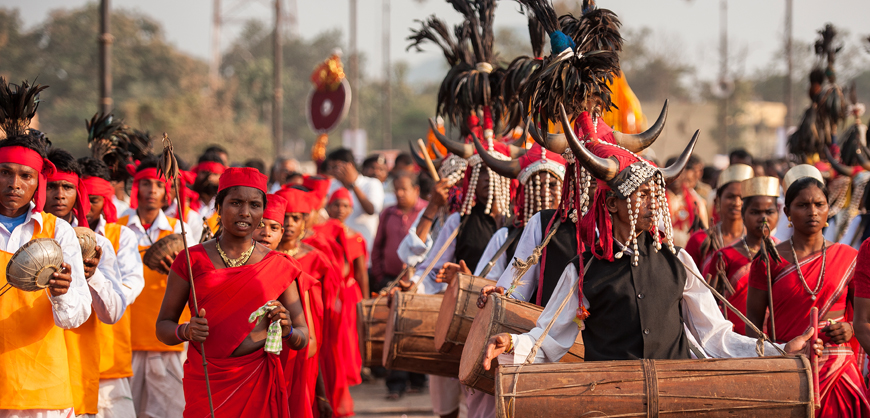
Also known as Jagdalpur Dussehra, the festival is dedicated to Goddess Danteshwari Devi, and a celebration of women empowerment. The grandeur of the festival concludes in the spectacular last ten days of Dusshera. Although the festival is popularly called Dusshera, the locals do not celebrate the victory of Lord Rama over Ravana. Rather, the festivities and rituals pay homage to Goddess Danteshwari, one of the 52 Shakti Peeths existing in the country.
The celebrations go on for 75 days and it is the longest celebration in the world. You can read more about it here – Bastar Dussehra – The World’s Longest Celebration
Dussehra in Andhra Pradesh and Telangana
While South India has diverse significance of the festival in its different states, they are all about honoring the divine goddess. Bathukamma, for instance, is the flower festival celebrated in Andhra Pradesh and Telangana at this time of the year. Bathukamma in Telugu translates to ‘Mother Goddess come alive’. The mother goddess referred to here is Gauri Devi, the mother of Goddess Durga. A festival of feminine felicitation and a celebration of women empowerment, Bathukamma is marked by women dressing up in vibrant attires and dancing in circles around a decorated pot to the folk songs.
Dussehra in Mysore
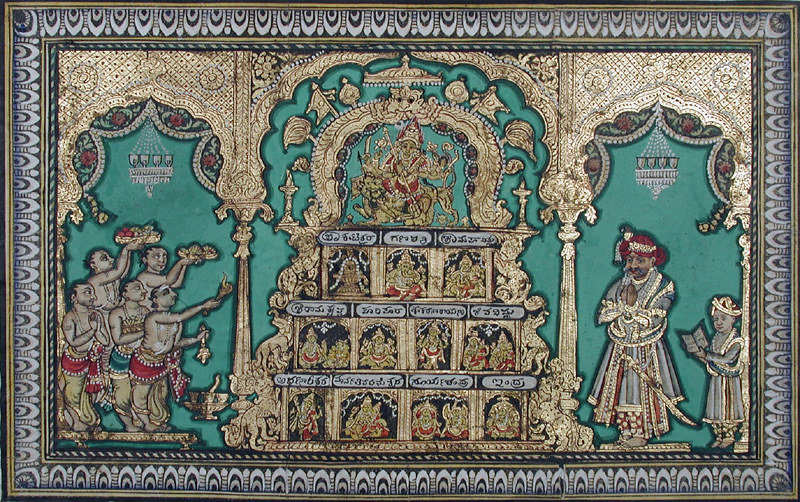
Chamundeshwari Temple in Mysore’s Chamundi Hills is one of the 18 prominent temples of Goddess Chamundi, where a 9-day festival is celebrated to honor the goddess. Chamundi is considered to be the Mother Goddess, the fierce avatar of Durga. As per the legend, with the amalgamation of powers vested in her by the powerful gods, she killed the demon Mahishasur. The hills in Mysore, previously known as Mahabala Hills, were named as Chamundi Hills as a tribute to the goddess.
Dussehra in Goa
All over India, it is believed that Lord Rama killed Ravana on the day of Dussehra, so his effigy is burnt. In Goa, this festival marks the union of Shiva with Shakti. Parvati, Shiva’s spouse, is worshipped in Goa in the different forms of goddess Durga, known locally as tarangas, including Mauli, Sateri, Shantadurga, and Bhumika. For the blessings of the gods and goddesses embodied in the tarangas, devotees swarm in great numbers to worship them.
A Tribute to Women
Despite the varied celebrations throughout the country, the festival honors the supreme goddess in one form or another. The idols and images of Durga are adorned and worshipped for 9 days, reaffirming the belief that the woman is the creator, the sustainer and the destroyer of life.
A modern woman of today is Durga who has the authority and power to fight the evils of the world. She is independent, she is fierce, she only requires a will to combat evil, be it at home, office, society or elsewhere!
To the Durga in all of us, we salute you!
Last Updated on August 5, 2024 by Shabari Shankar

